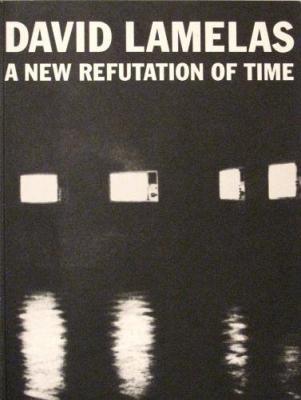ТОП просматриваемых книг сайта:
A New Refutation of Time. David Lamelas
Читать онлайн.Название A New Refutation of Time
Год выпуска 0
isbn 9789491435041
Автор произведения David Lamelas
Жанр Изобразительное искусство, фотография
Издательство Ingram
Kunstverein München
11.01.97–02.03.97
Witte de With, center for contemporary art, Rotterdam
05.04.97–25.05.97
DAVID LAMELAS
A NEW REFUTATION OF TIME
CONTENTS / INHALT
Lynda Morris
Interview with David Lamelas, London, December 1972
Gespräch mit David Lamelas, London, Dezember 1972
Heike Ander
David Lamelas, Raúl Escari
Benjamin H.D. Buchloh
Structure, Sign and Reference in the Work of David Lamelas
Struktur, Zeichen und Referenz in der Arbeit von David Lamelas
DAVID LAMELAS-A NEW REFUTATION OF TIME
‘Time, though we can intuit such an identity, is a delusion: the indistinction and inseparability of one moment from its apparent yesterday and another from its apparent today is quite enough to disintegrate it.’
Jorge Luis Borges
Historia de la eternidad
Both the work and person of David Lamelas transgress all geographic, aesthetic and cultural limits. He has never adhered to the apparent order of the art world’s norms and, in his nonchalant and scattered way, has always tested their conventionality. Since the early sixties, he has subjected the concept of ‘artwork’ to a veritable dissection process, redefining it as a model of communication. Lamelas’s rational analyses of exhibition contexts and of the passive role imposed on the public by the mass media are certainly among his most pertinent contributions.
His work is one of the best examples of transition in the cultural one-way traffic of the dominant northern countries, as well as one of the motors behind its reversal. Ever moving from continent to continent, his position in the North-South discussion only became clear when he left Los Angeles in 1988 to return to Europe. In contrast to other South American artists who sought asylum from dictatorships, such as Hélio Oiticica from Brazil, Lamelas did not focus on the suppressed precolonial culture but sought rather the very heart of the international production and consumption of mass media and popular culture. Lamelas’s decision to go to Hollywood in 1977, to adapt the film and television industry to his own needs and working context, can in retrospect be seen as the major fissure in his biography. His interest in the American mass media and his subsequent return to the United States can also be interpreted as a skirting of the South-American dictatorships’ imposed cultural censorship and information freeze. As an artist he produced work that was beyond the film industry’s comprehension.
The basic principle behind Lamelas’s earliest works runs counter to euphoric modernism and its claims of universality and belief in technical progress. He culled his subjects from popular cultures and media, and fragmented his ‘icons’ in paintings and installations. Within a few years he evolved his work from ‘shaped canvasses’ to sculpture that introduced site and sign as opposed to form, and architectural interventions that radically changed the exhibition space. Lamelas’s installation in Oscar Niemeyer’s Biennial Palace in San Paulo was his first radical criticism of the International Style as well as one of the earliest rebukes of the sensationalism of exhibitions due to the architectural imposition of presentation devices. One experienced a similar shock at the Office of Information about the Vietnam War at Three Levels: the Visual Image, Text and Audio, which he presented in the Argentinean pavilion at the controversial Biennale di Venezia of 1968.
During the eighties Lamelas expressed again a clear interest in the conventions of space and architecture through site-specific public works that centered on the urban landscape and oppositions between nature and artifice. Here the symbolic assumes the place previously occupied by the rational analysis, the media criticism, the appropriation of characters and the fictional narratives of his earlier films and video works.
In the exhibition and catalogue A New Refutation of Time, the title of an essay by Jorge Luis Borges read in Lamelas’s 1970 film Reading of an Extract from ‘Labyrinths’ by J.L. Borges, we have essentially focused on the development of Lamelas’s work from the early sixties to the mid-seventies. During this period the notion of time appears in numerous works that explore the possibilities of literary and cinematographic fiction in the visual arts. For Lamelas, the dialectic relations between a static and a moving image intensify the perception of reality like in a narrative construction.
This exhibition aims to rediscover one of the founders of an artistic practice that questions institutions, the status of art and the art market, and that connects the reality of the image with analytical questioning and poetic perception. By rounding out the information on the unprecedented initiators of what is now considered a self-evident artistic practice, we hope to broaden and deepen the discussion on the renewed role of art today. If the contemporaneity of an artwork lies in the moment of its conscious reception, then now must be the time in which Lamelas’s impressive production can be received in its complete topicality.
This ambitious project has been made possible in the first place thanks to the generosity and tireless involvement of David Lamelas. We would also like to thank Benjamin H.D. Buchloh and Lynda Morris for their collaboration on this catalogue; as well as Anke Bangma, Barbera van Kooij, and especially Heike Ander for the compilation of the archive and texts that form this catalogue and exhibition. We are particularly grateful to Klaus Richter of Richter Verlag in Dusseldorf for his commitment to this adventure. We especially want to thank the lenders of works to this exhibition and the institutions that have joined their efforts to make this project a success: the Fundació Antoni Tàpies, Barcelona and the Fundação de Serralves in Porto.
| Dirk SnauwaertKunstverein München | Bartomeu MaríWitte de With |
DAVID LAMELAS-A NEW REFUTATION OF TIME
‘Die Zeit, sofern es uns gelingt, diese Identität zu schauen, ist eine Täuschung. Die Ununterschiedenheit und Unauftrennbarkeit eines Augenblicks, ihres scheinbaren Gestern und

